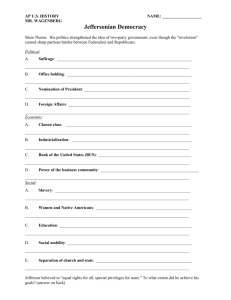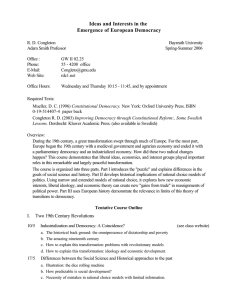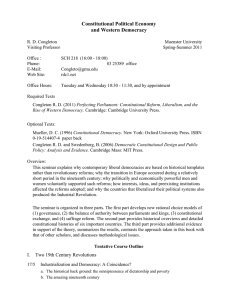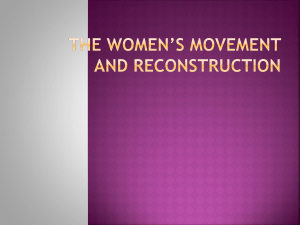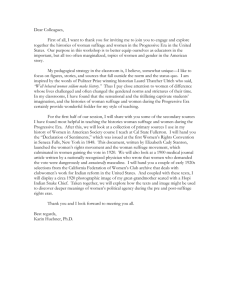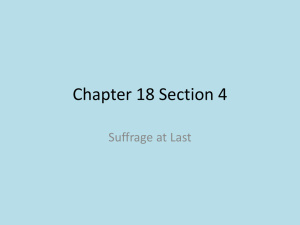I. Conections between European and US History
advertisement
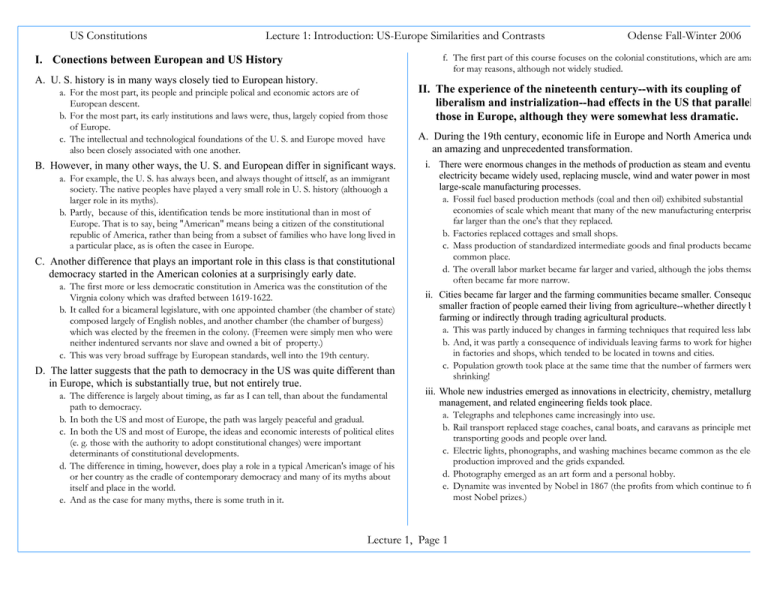
US Constitutions Lecture 1: Introduction: US-Europe Similarities and Contrasts Odense Fall-Winter 2006 f. The first part of this course focuses on the colonial constitutions, which are amazing for may reasons, although not widely studied. I. Conections between European and US History A. U. S. history is in many ways closely tied to European history. a. For the most part, its people and principle polical and economic actors are of European descent. b. For the most part, its early institutions and laws were, thus, largely copied from those of Europe. c. The intellectual and technological foundations of the U. S. and Europe moved have also been closely associated with one another. B. However, in many other ways, the U. S. and European differ in significant ways. a. For example, the U. S. has always been, and always thought of ittself, as an immigrant society. The native peoples have played a very small role in U. S. history (althouogh a larger role in its myths). b. Partly, because of this, identification tends be more institutional than in most of Europe. That is to say, being "American" means being a citizen of the constitutional republic of America, rather than being from a subset of families who have long lived in a particular place, as is often the casee in Europe. C. Another difference that plays an important role in this class is that constitutional democracy started in the American colonies at a surprisingly early date. a. The first more or less democratic constitution in America was the constitution of the Virgnia colony which was drafted between 1619-1622. b. It called for a bicameral legislature, with one appointed chamber (the chamber of state) composed largely of English nobles, and another chamber (the chamber of burgess) which was elected by the freemen in the colony. (Freemen were simply men who were neither indentured servants nor slave and owned a bit of property.) c. This was very broad suffrage by European standards, well into the 19th century. D. The latter suggests that the path to democracy in the US was quite different than in Europe, which is substantially true, but not entirely true. a. The difference is largely about timing, as far as I can tell, than about the fundamental path to democracy. b. In both the US and most of Europe, the path was largely peaceful and gradual. c. In both the US and most of Europe, the ideas and economic interests of political elites (e. g. those with the authority to adopt constitutional changes) were important determinants of constitutional developments. d. The difference in timing, however, does play a role in a typical American's image of his or her country as the cradle of contemporary democracy and many of its myths about itself and place in the world. e. And as the case for many myths, there is some truth in it. II. The experience of the nineteenth century--with its coupling of liberalism and instrialization--had effects in the US that paralleled those in Europe, although they were somewhat less dramatic. A. During the 19th century, economic life in Europe and North America underwe an amazing and unprecedented transformation. i. There were enormous changes in the methods of production as steam and eventually electricity became widely used, replacing muscle, wind and water power in most large-scale manufacturing processes. a. Fossil fuel based production methods (coal and then oil) exhibited substantial economies of scale which meant that many of the new manufacturing enterprises we far larger than the one's that they replaced. b. Factories replaced cottages and small shops. c. Mass production of standardized intermediate goods and final products became common place. d. The overall labor market became far larger and varied, although the jobs themselves often became far more narrow. ii. Cities became far larger and the farming communities became smaller. Consequently, smaller fraction of people earned their living from agriculture--whether directly be farming or indirectly through trading agricultural products. a. This was partly induced by changes in farming techniques that required less labor. b. And, it was partly a consequence of individuals leaving farms to work for higher wag in factories and shops, which tended to be located in towns and cities. c. Population growth took place at the same time that the number of farmers were shrinking! iii. Whole new industries emerged as innovations in electricity, chemistry, metallurgy, management, and related engineering fields took place. a. Telegraphs and telephones came increasingly into use. b. Rail transport replaced stage coaches, canal boats, and caravans as principle methods transporting goods and people over land. c. Electric lights, phonographs, and washing machines became common as the electrici production improved and the grids expanded. d. Photography emerged as an art form and a personal hobby. e. Dynamite was invented by Nobel in 1867 (the profits from which continue to fund most Nobel prizes.) Lecture 1, Page 1 US Constitutions Lecture 1: Introduction: US-Europe Similarities and Contrasts f. High strength steel and concrete became widely used in commercial buildings, factories, and manufactured products.. g. The automobile and bicycle emerged as "toys" toward the end of the century, but soon afterwards became a major industry. h. Electricity for use in manufacturing and for domestic applications as well as lighting became commonplace by the end of the century. Indoor heating and plumbing became common place. B. For the first time in history, the world was not only lit by fire. i. Industrial and labor cartels (unions) emerged as "factor owners" attempted to use collective bargaining to increase their personal share of the "gains from exchange." ii. Wealth had been historically based on land ownership, commerce, and political connections. a. These sources of wealth, of course, continued, but by the end of the 19th century, wealth became increasingly based on manufacturing, innovation, and specialization. iii. Both life spans and population increased as per capita income nearly tripled by the late nineteenth century. a. Together the various changes in the organization of production allowed a broad middle class to emerge for the first time in the industrializing countries of Europe. b. (The "frontier" had allowed a broad middle class to emerge in North America based on family farming in the seventeenth and eighteenth centuries. In Europe, land holdings and wealth tended to be very concentrated--substantially, among the royal family, the nobility and various wealthy farm families, although there were exceptions to this rule.) C. These economic changes were not entirely the result of technological shifts. i. In other older and wealthier societies, for example, the Ottoman Empire and China, access to the same technologies did not lead to such great transformations. ii. Industrialization in those countries was often suppressed by laws favoring their ruling elites. iii. In Europe and North America, public policies tended to encourage rather than to discourage industrialization. a. The medieval guild systems were largely ended in Europe during the 19th century. b. Antitrust policies were adopted in many countries. c. International trade was broadly encouraged through reductions in tariffs and other trade barriers. d. Rail, electrical, and telephone systems were supported through grants of right of ways and direct subsidies. e. There were great public education reforms which created many new publicly supported schools and colleges, and a better labor force. Odense Fall-Winter 2006 f. Various laws governing the structures that corporations could take were revised allowing more enterprises with more diffuse ownership to be organized with less risk shareholders. g. New areas of contract law and torts were developed and enforced by the courts. D. These new "industrial policies" were not accidental. i. In most cases, the pro-industrial policies were were lobbied for by narrow economic interest groups who profited most directly from the new policies, and also broader ideological groups favoring "free trade" on principle. ii. These policies made industrialization more widespread, more intense, more specialize and more productive. E. The emergence of new political interest groups in the nineteenth century can largely be explained as a consequence of the same technological changes that generated that century's rapid economic transformation. i. Greater income and wealth clearly provided more resources for individual pursuits, including politics. a. Both the new industries and the new organization of work, often created new or at least more obvious common economic interests. b. The concentration of workers and firms within cities also reduced the cost of organizing labor unions and producer cartels. ii. New Technologies also played a role in the emergence of the new interest groups. a. The organizational methods developed for coordinating large groups of laborers and input suppliers could also be applied to manage other collective activities, some of which had specific political aims. b. Technological innovations, such as the train, telegraph, and telephone, reduced the c of coordinating activities within cities and across the nation as a whole in those industries that remained diffuse, such as iron works and timber. c. The same reductions in transportation and communication costs that account for ma of the economic advantages of urban-based manufacturing also promote collective action by firms and workers by reducing organizational costs. d. In economic terms, industrialization caused the benefits of many kinds of collective action to rise and their costs to fall. III. Industrialization and Suffrage Movements in the 19th Century A. Coincident with the emergence of large industrial concerns was the emergence of a large number of ideological and economic interest groups that supported constitutional reform as well as ordinary public policy, throughou the rapidly industrializing world. Lecture 1, Page 2 US Constitutions Lecture 1: Introduction: US-Europe Similarities and Contrasts i. These groups often operated on a wide scale, both inside and outside government, and many thereby have affected the development of policies and institutions. ii. These same "liberal" interest groups also pressed for constitutional changes, and succeded in "causing" such changes throughout Northern Europe. iii. For example, Verney attributes much of the popular support for the Swedish constitutional reforms of 1866 to the efforts of economic liberals (1957, pp. 79-80) and those of 1920 to the efforts of labor unions and suffrage movements (1957, pp. 206-11). B. The new political alliances also lead to the emergence of new more disciplined political parties at the turn of the century, many of which favored expanded suffrage and trade liberalization. i. For example, in Sweden: a. The New Liberal Association was organized in 1868, but it was unsuccessful in its legislative aims and disintegrated in the next two years. b. the Social Democratic party emerged out of the suffrage and labor movements in 1889. c. The initially more influential Liberal party was organized in 1899 as a coalition of more or less like-minded members of Parliament organized over dinner at Tattersall’s restaurant. d. Nationwide economic organizations such as labor’s Landsorganisationen (LO) were organized in 1898 partly with the support of the Social Democrats. Industry’s employer association Svenska Arbetsgivarföreningen (SAF) was organized 1902 with the encouragement of the Conservative and Liberal Parties. (Heckscher 1954, pp. 136 and 235). ii. In the Netherlands, numerous parties formed and reformed during the late 19th century: a. The Anti Revolutionary Party (ARP) formed in 1879 to resist Liberal and Socialist groups and promote the traditional national character in the spirit of William the Silent. (The William that organized Leiden's Relief and much of the Dutch revolt.) b. Several liberal and social democratic parties formed at about the same time: including the Liberal Union, the Free Liberal League (1891), the Social Democratic Workers Party and the Social Democratic League. c. Religion based parties were also created during this period as with the Catholic State Party and the Christian Historical Union (1908). d. In 1906, the Netherlands Federation of Trade Unions was founded (NVVV). iii. In the United Kingdom: a. For much of the early period, parliamentary politics were dominated by two somewhat loosely organized parties the Liberal Party (formed from the old Whig Party, Radicals and Reformers) and the Conservative Party (formed from the old Tory Party). b. However, toward the end of the 19th Century, other parties emerged: c. The Independent Labor Party was founded in 1893 and the Labor Part was established in 1900. Odense Fall-Winter 2006 d. The Trade Union Congress (TUC) was founded in 1868, Labor unions were legalized in 1871, The first meeting of the London Chamber of Commerce took place in 1882 The National Union of General and Municipal workers formed in 1889. iv. Similar patterns of interest groups were occurring throughout in the United States, as woman's suffrage and temperance movements emerged along side farmer cooperative and labor movements. C. In Europe, a series of constitutional reforms were adopted peacefully. i. These reforms generally modified existing institutions rather then replacing them whole cloth. ii. In general, parlaments became more powerful and suffrage expanded throughout the 19th century. iii. Universal male suffrage was often introduced just before WWI and womans suffrage just after. D. In the US, suffrage was already very broad for men, as wealth restrictions wer generally eliminated in the early 19th century. i. However, somewhat similar suffrage movements lead to womans suffrage after WWI ii. And, in many parts of the US suffrage for blacks was made essentially equal to that o those of European dissent. iii. [This was not true of the southeastern United States, where black gained political power immediately after the American civil war, but lost much of their political influence during the last two decades of the 20th century, as election laws were adopt which made it difficul for most blacks (and many "whites' ) to cast votes in elections.] E. Overall, the political changes in Europe were much more dramatic than in the US, but the pressures and policy changes in the US were similar in many ways those adopted in Europe. IV. Post WWII: Twentieth Century Reforms A. Europe and the U. S. continued to be influenced by similar technological and ideological developments in the 20th century. i. And similar constitutional changes in the end took place. ii. Civil and political rights became more secure, government services expanded, and a fairly high "safety net" was erected by central governments on both continents after WWII. B. In the US, the supreme court played a new and important role in constitutional developments after WWII, that was quite different than the role constitutional courts played in most European countries. Lecture 1, Page 3 Suffrage Expansion in Europe During the 19th Century Popular Suffrage and Population in 19th Century Netherlands, Sweden, and the United Kingdom (in thousands, from Cook and Paxton, European Political Facts 1848-1918) Year Netherlands (UK, then NL electors election yrs.) Sweden United Kingdom pop (interp. to 2*electors/ electors (in pop (interp. to 2*electors/ electors pop (interp. to 2*electors/ election yr.) pop nearest yr) act. elect. yr.) pop nearest >1886 act. elect. yr.) pop 1831 435.4 26081.57 0.03 1833 652.8 26211.46 0.05 1866 1056.7 30206.1 0.07 1869 1995.1 30973.32 0.13 1883 2618.5 35454.42 0.15 1886 4380.5 36308.85 0.24 1888 292.6 4471.27 0.13 274.7 4719.2 0.12 1891 293.8 4629.92 0.13 288.1 4784.98 0.12 1894 299.1 4807.7 0.12 339.9 5101.26 0.13 1897 576.6 4985.48 0.23 1901 609.6 5254.84 0.23 1905 752.7 5556.52 0.27 1909 843.5 5858.2 0.29 503.1 5445.2 0.18 1913 960.6 6243.4 0.31 1066.2 5558.84 0.38 1918 1081.5 6690.1 0.32 1124 5777.46 0.39 1922 1844.8 7079.36 0.52 Lecture V, Page 4 37732.9 6730.9 41458.7 0.32 7710 44976.44 0.34 21392.3 43833.75 0.98 21127.6 42957.44 0.98
